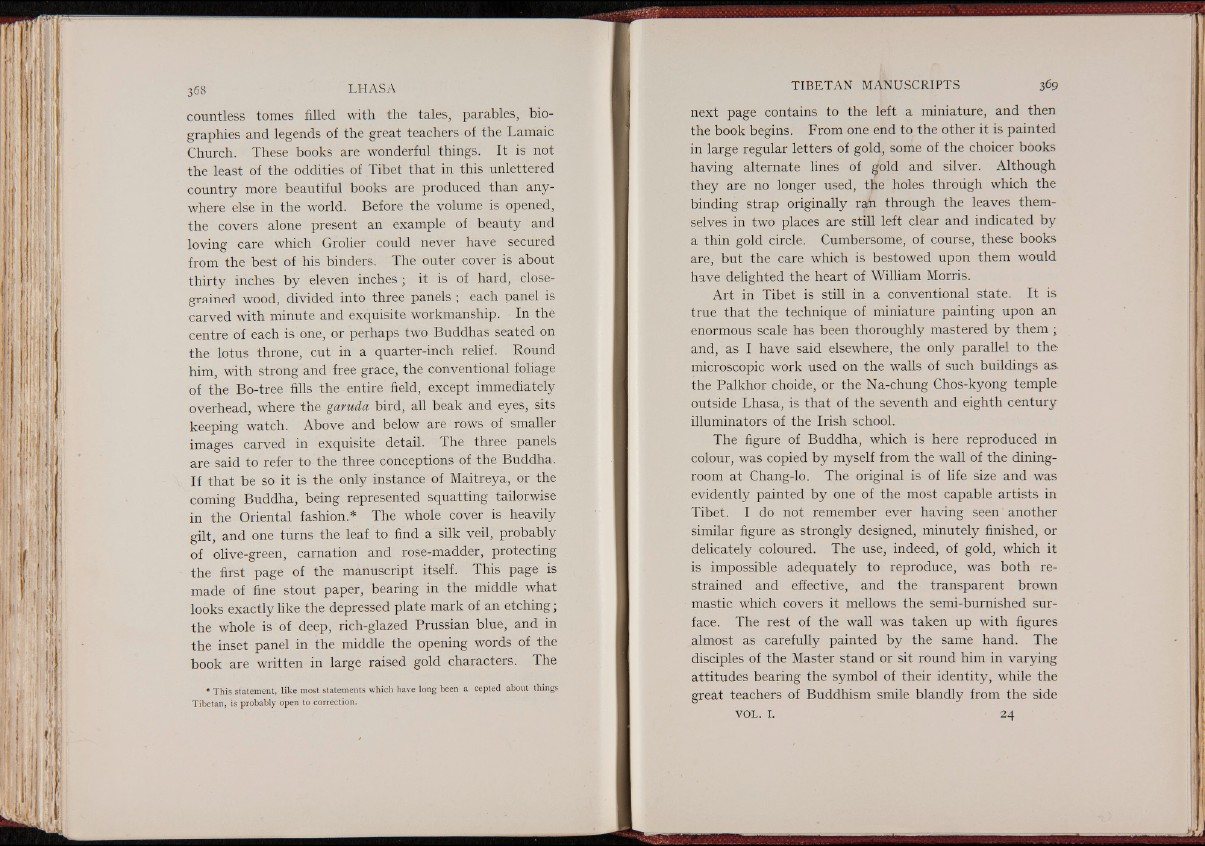
countless tomes filled with the tales, parables, biographies
and legends of the great teachers of the Lamaic
Church. These books are wonderful things. It is not
the least of the oddities of Tibet that in this unlettered
country more beautiful books are produced than anywhere
else in the world. Before the volume is opened,
the covers alone present an example of beauty and
loving care which Grolier could never have secured
from the best of his binders. The outer cover is about
thirty inches by eleven inches ; it is of hard, close-
grained wood, divided into three panels ; each panel is
carved with minute and exquisite workmanship. In the
centre of each is one, or perhaps two Buddhas seated on
the lotus throne, cut in a quarter-inch relief. Round
him, with strong and free grace, the conventional foliage
of the Bo-tree fills the entire field, except immediately
overhead, where the garuda bird, all beak and eyes, sits
keeping watch. Above and below are rows of smaller
images carved in exquisite detail. The three panels
are said to refer to the three conceptions of the Buddha.
If that be so it is the only instance of Maitreya, or the
coming Buddha, being represented squatting tailorwise
in the Oriental fashion.* The whole cover is heavily
gilt, and one turns the leaf to find a silk veil, probably
of olive-green, carnation and rose-madder, protecting
the first page of the manuscript itself. This page is
made of fine stout paper, bearing in the middle what
looks exactly like the depressed plate mark of an etching;
the whole is of deep, rich-glazed Prussian blue, and in
the inset panel in the middle the opening words of the
book are written in large raised gold characters. The
* This statement, like most statements which have long been a cepted about things
Tibetan, is probably open to correction.
next page contains to the left a miniature, and then
the book begins. From one end to the other it is painted
in large regular letters of gold, some of the choicer books
having alternate lines of gold and silver. Although
they are no longer used, tfie holes through which the
binding strap originally rah through the leaves themselves
in two places are still left clear and indicated by
a thin gold circle. Cumbersome, of course, these books
are, but the care which is bestowed upon them would
have delighted the heart of William Morris.
Art in Tibet is still in a conventional state. It is
true that the technique of miniature painting upon an
enormous scale has been thoroughly mastered by them j
and, as I have said elsewhere, the only parallel to the
microscopic work used on the walls of such buildings as.
the Palkhor choide, or the Na-chung Chos-kyong temple:
outside Lhasa, is that of the seventh and eighth century
illuminators of the Irish school.
The figure of Buddha, which is here reproduced in
colour, was copied by myself from the wall of the diningroom
at Chang-lo. The original is of life size and was
evidently painted by one of the most capable artists in
Tibet. I do not remember ever having seen another
similar figure as strongly designed, minutely finished, or
delicately coloured. The use, indeed, of gold, which it
is impossible adequately to reproduce, was both restrained
and effective, and the transparent brown
mastic which covers it mellows the semi-burnished surface.
The rest of the wall was taken up with figures
almost as carefully painted by the same hand. The
disciples of the Master stand or sit round him in varying
attitudes bearing the symbol of their identity, while the
great teachers of Buddhism smile blandly from the side
v o l . 1. 24